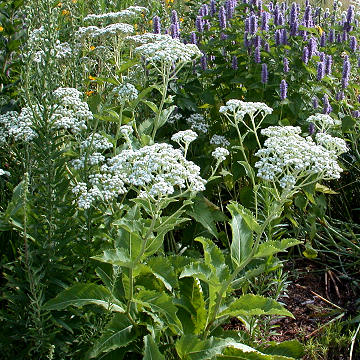

Parthenium integrifolium - (image 1 of 5)
Taxonomy
Family: Asteraceae
Habitat
Prairie remnants, sand prairies, dry woods.
Associates
Distribution
VA west to southeast MN, south to GA and AK. Naturalized in MA.
Morphology
Stout perennial to 1 m from a short, tuberous root. Stem simple or branched above, strigose puberulent above and glabrous below. Leaves crenate-serrate, scabrous to subglabrous; basal leaves long petiolate, the blade lance-elliptic to broadly ovate and up to 20 cm long and 10 cm wide; cauline leaves typically reduced on progressively shorter petioles; upper leaves often sessile and clasping. Inflorescence flat-topped; heads numerous; disk 4-7 mm wide; rays usually less than 2 mm. Achenes obovate, black.
Notes
Flowers June to September.
Wetland indicator: Upland
The name Wild Quinine and another common name, American Feverfew, hint at a possible historic use of this plant for the treatment of fevers.
References
Gleason, Henry A. and A. Cronquist. 1991. Manual of Vascular Plants of Northeastern United States and Adjacent Canada. Second Ed.
The New York Botanical Garden. Bronx, NY
Swink, F. and G.
Wilhelm. 1994. Plants of the Chicago Region.
Indiana Academy of Science. The Morton Arboretum. Lisle, Illinois.
|
Michael Hough © 2009 |